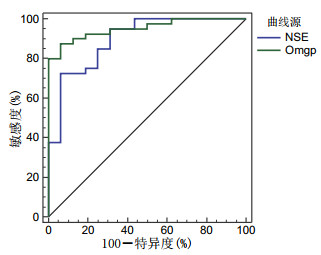Changes in plasma odendmcyte-myelin glycoprotein levels for the diagnosis of brain injury in premature infants
-
摘要:
目的 通过测定神经元特异性烯醇化酶(neuron specific enolase,NSE)和少突胶质细胞髓鞘糖蛋白(odendmcyte-myelin glycoprotein,Omgp)水平,探讨其在早产儿脑损伤中的诊断价值。 方法 选取2019年1—12月在淮安市妇幼保健院新生儿医学中心住院治疗的80例早产儿,根据颅脑B超及MRI结果,按有无脑损伤分为脑损伤组(40例)及无脑损伤组(40例)。收集研究对象出生后6 h、72 h、7 d的血液标本,采用ELISA法测定NSE、Omgp水平,分析其对早产儿脑损伤的诊断价值。 结果 (1) 脑损伤组生后6 h、72 h、7d NSE、Omgp水平较无脑损伤组显著升高。(2)早产儿脑损伤组生后6 h Omgp水平的ROC曲线下面积最大,为0.952,约登指数为0.813,灵敏度为87.50%,特异度为93.75%,对应的最佳阈值为57.971,阳性预测值97.22%,阴性预测值75.03%,高于NSE。(3)生后6 h、72 h、7 d Omgp水平与矫正胎龄40周NBNA评分负相关,相关系数分别为r=-0.728、-0.732、-0.752,均P<0.01;生后6 h、72 h及7 d NSE与NBNA评分无明显相关性(均P>0.05)。 结论 生后6 h NSE、Omgp水平可以作为BIPI的潜在诊断标志物,其中Omgp水平诊断准确率较高。生后6 h、72 h、7 d Omgp水平可能是预测BIPI预后的良好生物标志物。 -
关键词:
- 早产儿 /
- 脑损伤 /
- 神经元特异性烯醇化酶 /
- 少突胶质细胞髓鞘糖蛋白
Abstract:Objective To investigate the relationship between brain injury and plasma odendmcyte-myelin glycoprotein (Omgp) levels and neuron-specific enolase (NSE) in premature infants, and analyze its clinical significance in premature infants with brain injury. Methods Total 80 cases of premature infants who were hospitalized in the Neonatal Medical Centre of Huai'an Maternal and Child Health Hospital from January 2019 to December 2019 were included in the study. According to the results of craniocerebral imaging, all infants were divided into brain injury group and non-brain injury group. Blood samples were obtained at 6, 72 and 168 h after birth. Levels of NSE and Omgp were detected via ELISA. The predictive value of plasma NSE and Omgp for brain injury in premature infants (BIPI) was analysed. Results (1) The NSE and Omgp levels in the brain injury group were significantly higher than that in the non-brain injury group at 6, 72 and 168 h after birth. (2)The area under ROC curve of OMgp level at 6 h after birth was the largest, which was 0.952, Yoden index was 0.813, sensitivity was 87.50%, specificity was 93.75%. The corresponding optimal threshold was 57.971, positive predictive value was 97.22%, and negative predictive value was 75.03%, which was higher than NSE. (3)The levels of Omgp at 6, 72 and 168 h were significantly negatively correlated with the NBNA score at 40 weeks of corrected gestational age (r=-0.728, -0.732 and -0.752, respectively; all P < 0.01). Levels of NSE had no significant correlation with prognosis at 6, 72 and 168 h after birth (all P>0.05) but could predict the prognosis. Conclusion Levels of NSE and Omgp at 6 h after birth are all correlated with BIPI and can be used as potential diagnostic markers. The diagnostic accuracy of Omgp level is higher. The Omgp levels at 6, 72 and 168 h after birth may be a good biomarker for predicting BIPI prognosis. -
表 1 2组早产儿一般资料比较(x±s)
组别 例数 性别
(男/女,例)胎龄
(周)分娩方式(阴道分娩/
剖宫产,例)出生体重
(g)住院时间
(d)胎膜早破
[例(%)]脑损伤组 40 18/22 34.21±1.57 21/19 2 241.75±480.67 32.75±7.01 19(47.50) 无脑损伤组 40 17/23 34.72±2.03 25/15 2 206.50±594.09 30.13±5.92 20(50.00) 统计量 0.051a 1.269b 0.818a 0.292b 1.810b 0.050a P值 0.822 0.208 0.366 0.771 0.074 0.823 组别 例数 产前感染
[例(%)]妊娠期高血压
[例(%)]羊水污染
[例(%)]1 min Apgar评分
(分)5 min Apgar评分
(分)无创通气
[例(%)]有创通气
[例(%)]脑损伤组 40 27(67.50) 28(70.00) 23(57.50) 7.50±0.91 8.98±0.66 21(52.50) 12(30.00) 无脑损伤组 40 25(62.50) 27(67.50) 20(50.00) 7.68±0.86 9.00±0.60 27(67.50) 19(47.50) 统计量 0.220a 0.058a 0.453a 0.887b 0.177b 1.875a 2.581a P值 0.639 0.809 0.501 0.378 0.860 0.171 0.108 注:a为χ2值,b为t值。 表 2 2组早产儿NSE水平比较(x±s,μg/L)
组别 例数 NSE水平 6 h 72 h 7 d 脑损伤组 40 13.35±2.13 13.08±2.30 11.21±1.90 无脑损伤组 40 9.73±1.91 9.73±1.75 9.12±1.89 t值 8.003 7.331 4.932 P值 <0.001 <0.001 <0.001 表 3 2组早产儿Omgp水平比较(x±s,ng/L)
组别 例数 6 h 72 h 7 d 脑损伤 40 68.03±10.02 74.50±11.32a 73.12±11.54ab 无脑损伤 40 48.70±4.63 49.18±5.42 49.40±4.62 t值 11.076 12.759 12.069 P值 <0.001 <0.001 <0.001 注:与6 h组比较,aP<0.05;与72 h组比较,bP<0.05。 表 4 新生儿血浆中NSE、Omgp对BIPI的预测价值
标志物 AUC
(95% CI)约登
指数截距 敏感性
(%)特异性
(%)阳性预测
值(%)阴性预测
值(%)NSE 0.895(0.784~0.961) 0.663 12.305 72.50 93.75 96.66 57.73 Omgp 0.952(0.859~0.991) 0.813 57.971 87.50 93.75 97.22 75.03 表 5 新生儿脑损伤组NSE、Omgp水平与NBNA的相关性
项目 6 h 72 h 7 d r值 P值 r值 P值 r值 P值 NSE 0.005 0.975 -0.177 0.275 -0.159 0.326 Omgp -0.728 < 0.001 -0.732 < 0.001 -0.752 < 0.001 -
[1] 王晓杰, 温秀兰, 谢婉花. 广州市妇女儿童医疗中心早产儿流行病学调查[J]. 深圳中西医结合杂志, 2018, 28(11): 16-17. https://www.cnki.com.cn/Article/CJFDTOTAL-SZZX201811007.htm [2] 王晓鹏, 田秀英, 郑军, 等. 天津市早产儿流行病学调查[J]. 中国妇幼保健, 2016, 31(24): 5473-5475. https://www.cnki.com.cn/Article/CJFDTOTAL-ZFYB201624090.htm [3] HE S W, XIONG Y E, ZHU L H, et al. Impact of family integrated care on infants'clinical outcomes in two children's hospitals in China: A pre-post intervention study[J]. Ital J Pediatr, 2018, 44(1): 65. doi: 10.1186/s13052-018-0506-9 [4] 中华医学会儿科学会新生儿学组. 中国七大城市早产儿脑损伤发生率的多中心调查报告[J]. 临床儿科杂志, 2011, 29(11): 1001-1011. doi: 10.3969/j.issn.1000-3606.2011.11.001 [5] 黄会芝, 胡晓峰, 温晓红, 等. 早产儿肺功能发育与脑损伤关系的初步探讨[J]. 安徽医学, 2016, 37(1): 27-30. doi: 10.3969/j.issn.1000-0399.2016.01.007 [6] 冷洁, 汪柳旭, 魏晋蓉, 等. DWI联合血清NSE检测在诊断早产儿局灶性脑白质损伤中的应用[J]. 中国CT和MRI杂志, 2019, 17(8): 28-31. doi: 10.3969/j.issn.1672-5131.2019.08.009 [7] 罗爱芳, 陈水斌, 欧阳林. 磁共振功能成像在创伤性脑损伤的特征分析[J]. 中国医学装备, 2019, 16(6): 53-56. doi: 10.3969/J.ISSN.1672-8270.2019.06.014 [8] 黄瑞丽, 谭卫锋, 董凌云. 颅脑超声在早产儿脑损伤早期诊断及预后评价中的应用[J]. 包头医学, 2020, 44(1): 25-27. doi: 10.3969/j.issn.1007-3507.2020.01.012 [9] 刘敬, 俞惠民, 毛健, 等. 早产儿脑损伤诊断与防治专家共识[J]. 中国当代儿科杂志, 2012, 14(12): 883-884. https://www.cnki.com.cn/Article/CJFDTOTAL-DDKZ201212000.htm [10] 鲍秀兰, 刘维民. 新生儿行为神经测定和观察在早产儿及小婴儿脑发育评估和早期干预中的应用[J]. 中国实用儿科杂志, 2017, 32(11): 820-822. https://www.cnki.com.cn/Article/CJFDTOTAL-ZSEK201711008.htm [11] 张晓燕, 芦红茹, 宋红霞, 等. 20项新生儿行为神经测定评分法对早产儿脑发育及脑损伤的评价[J]. 中国儿童保健杂志, 2010, 18(2): 159-162. https://www.cnki.com.cn/Article/CJFDTOTAL-ERTO201002029.htm [12] THELIN E P, JOHANNESSON L, NELSON D, et al. S100B is an important outcome predictor in traumatic brain injury[J]. J Neurotrauma, 2013, 30(7): 519-528. doi: 10.1089/neu.2012.2553 [13] 阮学东, 叶飞, 邢海燕, 等. S100B蛋白在癫痫患儿血清中的表达及其临床意义[J]. 中华全科医学, 2014, 12(8): 1283-1285. https://www.cnki.com.cn/Article/CJFDTOTAL-SYQY201408035.htm [14] 中华医学会儿科学分会新生儿学组, 《中华儿科杂志》编辑委员会. 新生儿高胆红素血症诊断和治疗专家共识[J]. 中华儿科杂志, 2014, 52(10): 745-748. doi: 10.3760/cma.j.issn.0578-1310.2014.10.006 [15] ISGRÒ M A, BOTTONI P, SCATENA R. Neuron-Specific enolase as a biomarker: biochemical and clinical aspects[J]. Adv Exp Med Biol, 2015, 867: 125. doi: 10.1007%2F978-94-017-7215-0_9.pdf [16] 张江波, 束汉生. 神经元特异性烯醇化酶在神经损伤中的研究进展[J]. 中华全科医学, 2016, 14(1): 125-127. https://www.cnki.com.cn/Article/CJFDTOTAL-SYQY201601045.htm [17] MESHCHERYAKOV S V, SEMENOVA Z B, LUKIANOV V I, et al. Prognosis of severe traumatic brain injury outcomes in children[J]. Acta Neurochir Suppl, 2018, 126: 11-16. doi: 10.1007/978-3-319-65798-1_3 [18] 刘聪聪, 汤继宏, 王曼丽, 等. 新生期大鼠惊厥发作后血清神经元特异性烯醇酶、S100蛋白的动态变化及其意义[J]. 临床神经病学杂志, 2015, 28(4): 273-275. https://www.cnki.com.cn/Article/CJFDTOTAL-LCSJ201504017.htm [19] MERCIER E, BOUTIN A, SHEMILT M, et al. Predictive value of neuron-specific enolase for prognosis in patients with moderate or severe traumatic brain injury: a systematic review and meta-analysis[J]. CMAJ Open, 2016, 4(3): 371-382. doi: 10.9778/cmajo.20150061 [20] HERGENROEDER G W, REDELL J B, MOORE A N, et al. Biomarkers in the clinical diagnosis and management of traumatic brain injury[J]. Mol Diagn Ther, 2008, 12(6): 345-358. doi: 10.1007/BF03256301 [21] 裘艳梅, 侯洪涛, 王炜, 等. 动脉血气分析、神经烯醇化酶及血清神经胶质纤维酸性蛋白在早产儿脑伤早期诊断中的价值[J]. 实用医学杂志, 2016, 32(17): 2847-2850. doi: 10.3969/j.issn.1006-5725.2016.17.019 [22] LEE X, HU Y, ZHANG Y, et al. Oligodendrocyte differentiation and myelination defects in OMgp null mice[J]. Mol Cell Neurosci, 2011, 46(4): 752-761. doi: 10.1016/j.mcn.2011.02.008 [23] YIU G, HE Z. Glial inhibition of CNS axon regeneration[J]. Nat Rev Neurosci, 2006, 7(8): 617-627. doi: 10.1038/nrn1956 [24] 王杰华, 洪诸权, 潘莹. 脂肪干细胞移植对脑缺血大鼠脑组织MAG和OMgp表达的影响[J]. 临床和实验医学杂志, 2018, 17(21): 2252-2255. doi: 10.3969/j.issn.1671-4695.2018.21.004 -





 下载:
下载:


